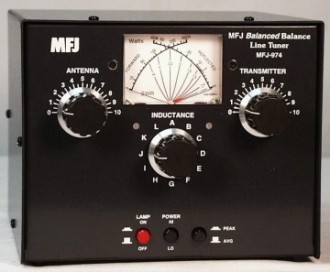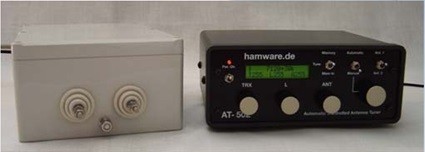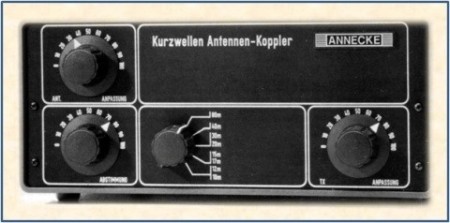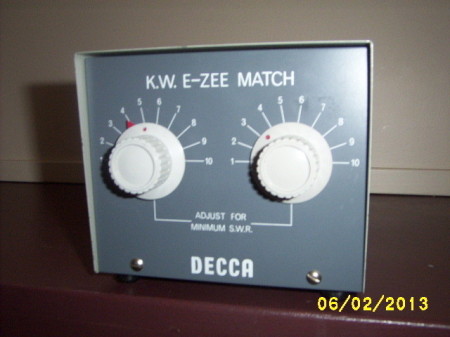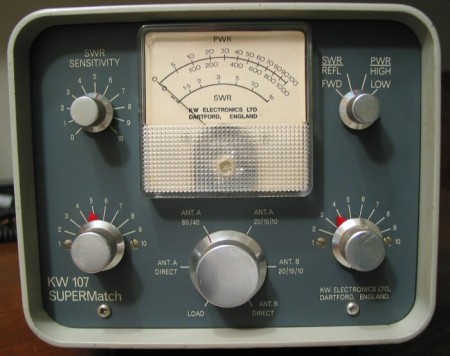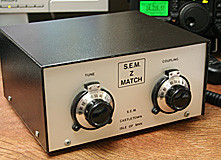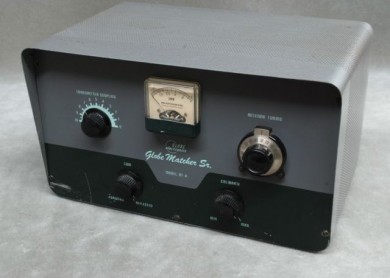Antenna Tuners
Low Power Symmetrical Matchboxes
[ MARKET OVERVIEW ]
Symmetrical (Balanced) Matchboxes are the preferred way of matching openwire fed antennas to transmitters. In this section I will review what's currently available on the market in the low power class, as well as show you a few blasts form the past.
A description of the various symmetrical technologies is here: SYMMETRICAL MATCHBOXES
AGAIN, BUYER BEWARE: Many manufacturers advertise their asymmetrical matchboxes as matchboxes for symmetrical applications. I caution you to be aware of the risks in doing this; specifically, problems with RF in the shack when running high power. IT BURNS!
UNFORTUNATELY LOW POWER SYMMETRICAL / BALANCED MATCHBOXES ARE RARE.
New, Used, or Homebrew - those are your choices.
Before you reject homebrew, you should evaluate your needs and determine what your really need. Why do you want a symmetrical matchbox anyway?
In many situations, the user will have more than one antenna and the symmetrical matchbox is really only needed for the lower bands (160/80/40). Often, only one or two of these bands are needed. In that case it may make good sense to homebrew a simple symmetrical matchbox.
THE BIG PROBLEM WITH MULTI-BAND SYMMETRICAL
MATCHBOXES IS THE BANDSWITCHING.
Bandswitching symmetrical matchboxes is very complex, and requires special, non-standard switches. The problem is not just the price - you can't even find them! This makes home-brewing a switchable multi-band matchbox something close to impossible - but that should not stop you from home-brewing if you only need one or two bands.
CHOOSING A NEW SYMETRICAL MATCHBOX IS EASY:
THERE'S ONLY ARE ONLY TWO CHOICES!
To my knowledge, the MFJ-974 (B or HB) matchbox is the only manually tuned low-power [desktop] symmetrical matchbox currently available on the commercial market. It is reasonably priced and a very good matchbox. It has somewhat higher losses at low impedances, so the key here is to build antennas which have higher impedances.
FORGET WHAT YOU READ ABOUT MFJ AND POOR QUALITY!
Usually the problems cited by users with bad experience are due to OPERATOR ERROR!
(See also: HOW TO KILL A MATCHBOX)
The number 1 problem occuring is burned up switches. Specifically a burned up inductance switch. This is most often caused by turning the switch under power. NEVER DO THIS! But many LIDS do it. The result is a burned up inductance switch. READ THE INSTRUCTIONS and this matchbox will do a good job for you. My oldest MFJ matchbox is now over 25 years old, and it works like new.
My MFJ-974-B has been used at several field days, as well as many of my camping trips. It works great. Twice the FD team chose it over the Johnson Viking Matchbox, because the Viking could not match all bands without arcing on some bands. See pictures below.
THE SECOND MATCHBOX in this category is the [German] HAMWARE AT-502. This is actually a Remote Matchbox, using a symmetrical Pi circuit. It has a tiny tuning unit that sits on the desk, but the works sit outside in the garden. An RS-232 cable is used to send control signals to the matchbox. This is a really fine symmetrical matchbox, but it is NOT CHEAP. See pictures below.
THE USED EQUIPMENT MARKET:
If we consider the used market, there are only a couple more symmetrical matchboxes as alternatives to the MFJ-974, but not many. All in all, this segment of the market has been neglected by the commercial vendors. More accurately, the commercial vendors have taken the cheap way out and proposed their asymmetrical matchboxes as symmetrical solutions.
This is not very kosher! SHAME ON THEM. ALL OF THEM!
SYMMETRICAL MATCHBOXES ON THE USED MARKET:
- Johnson Viking [275w] Matchbox. Don't let the 275w fool you. This will easily handle several hundred watts in SSB or CW modes. It was rated for 275w input power in AM mode. This is about 150w output power in this mode, or about 450w output in SSB mode.
- Annecke [200w] Symmetrical Koppler. This is a German improved version of the Johnson Viking Matchbox. It has significant improvements over the Viking. This matchbox may be safely used for output power levels of up to about 200w SSB or CW. For more information on the imprvements over the Viking, click here: Viking vs. Annecke .
- DECCA E-Zee Match. This matchbox was built in the U.K. in the 1970s. It is a "Z-Match". The Z-Match is a symmetrical matchbox but it's efficiency is not as good as the Annecke when matching extremely high or extremely low impedances. In practice, this is not a serious problem. This matchbox can typically be used for power levels up to 100w output on SSB and CW. It tends to arc a bit earlier than a Viking of Annecke, but that can be cured by inserting just a little more feedline. How to do that will be described HERE. (Note: Link not finished yet).
- S.E.M. Z Match. This 2-tank circuit classical Z-Match was built by S.E.M. of Douglas, Isle of Mann. It was an insider tip for UK amateurs, but is somewhat unknown outside of the U.K. Like all classical Z-match matchboxes, you must manually switch antenna terminals when changing from the low bands to the high bands.
- Others: There were a few others, but they are so scarce that it does not warrent mentioning them here.
- ALTERNATIVES: Purchase a high power symmetrical matchbox, or home-brew your own.
- There are a number of small niche players in the symmetrical matchbox market, especially here in Europe, but most of these are building high power matchboxes, and
they are NOT CHEAP:
- HamWare http://www.hamware.de/
- Christian Koppler http://www.dc4jg.de/html/sym_koppler.html
- FunkAmateur http://www.box73.de/product_info.php?products_id=2463
- There are a number of small niche players in the symmetrical matchbox market, especially here in Europe, but most of these are building high power matchboxes, and
they are NOT CHEAP:
LOW POWER ALTERNATIVE: Using an asymmetrical matchbox here (100w or less), together with a good 1:1 Current Balun is usually an acceptable solution. Unfortunately this not true when running high power.
BOTTOM LINE: If you want to build just one antenna and use it on as many bands as possible, feed it with openwire and buy yourself an MFJ-974B and be happy! If you are willing to spend a little more, you may opt for the HamWare AT-502.
PICTURES:
LOW POWER SYMMETRICAL (BALANCED) MATCHBOXES
AVAILABLE NEW:
MFJ-974B / MFJ-974HB
Balanced-T matchbox for 80-10m (B) / 160-10m (HB).
General purpose symmetrical matchbox which is very good at matching a broad range of impedances to 50 Ohms. Losses are a bit high on the low bands, especially by low impedances. Never-the-less it will still match antennas here. For most other applications it is very good.
HAMWARE AT-502
Ballanced Pi-Network matchbox with good effeciency. This is a "Remote Matchbox". The RF unit is depolyed outside, while the control unit sits on your desktop. The matchbox must initially be manually tuned, but it has a large number of memories. Once it has been tuned on all bands, it stores and remembers the settings, enabling instant band change. This is currently the best low power balanced matchbox available on the market.
.
LOW POWER SYMMETRICAL (BALANCED) MATCHBOXES
AVAILABLE ONLY ON THE USED MARKET:
ANNECKE 200 WATT SYMMETRISCHE KOPPLER
This is an improved version of the famous Johnson Viking Matchbox. Its impedance matching range is superior to that of the Johnson Viking. With its link-coupled technology, it offers excellent efficiency. In addition to impedance matching, it also has good harmonic surpression and band-pass-filter functionality which helps the receiver. Unfortunately few of its owners part with it, so it is rarely seen on the used market.
For more information on this matchbox, see: ANNECKE SYMMETRISCHE KOPPLER .
Annecke_SymKopManual.pdf
PDF-Dokument [690.6 KB]
annecke%20200W%20manual.pdf
PDF-Dokument [1.8 MB]
DECCA KW E-ZEE MATCH
The name is misleading. It is a 100w (out) matchbox, not a Kilowatt matchbox!
This matchbox uses the classical double-tank circuit Z-Match design. When switching between the high bands and the low bands, you have to manually move the openwire feedline between a different set of terminals.
Excellent low-cost balanced matchbox, but very rare, except in the U.K.
DECCA KW 107 SUPERMatch
The name is misleading. It is a 100w (out) matchbox, not a Kilowatt matchbox!
This matchbox uses the classical double-tank circuit Z-Match design. It is identical to the E-ZEE Match above, except it also has a Watt Meter and an Antenna Switch.
This model is VERY RARE. I have only seen these for sale in the U.K.
JOHNSON VIKING MATCHBOX
This is the Grandfather of all commercial symmetrical matchboxes. Its reputation as a "match anything" matchbox is greatly exagerated. In fact it is somewhat limited in what it can match.
The Annecke Symmetrische Koppler improved on the circuit design and is a much better matchbox.
When purchasing ne of these on the used market, ALWAYS look inside the box before buying. Often you will find them in misarable shape, melted coils, etc. After all, they are now over 50 years old.
Johnson Viking Matchbox Instruction Manu[...]
PDF-Dokument [642.7 KB]
SEM Trans Z Match
The picture is small, but it is also a small matchbox.
This is a classical Z-Match Matchbox, where you must manually move the feedline between two sets of terminals on the back panel when switching between 80 thru 30m, or 20 thru 10m.
The two variable capacitors each have a vernier drive with 0 to 100 scale, making them easy to tune and enabling tuning to a list of pre-sets when changing bands. In order to appreciat this, you need to try tuning one of the other Z-match boxes without verniers, and then try this one. LOVELY!
Outside of the U.K., these matchboxes are extremely rare.
WRL GLOBE MATCHER SR AT-4
This 1957 Symmetrical Matchbox was a classical Z-Match. It was rated 400 Wats (Input Power), which we could call perhaps 200 Watts today. It covered 80 through 10m and had the typical dual set of antenna terminals on the reap panel, one for 80/40 and one for 20 thru 10.
I was unable to find a circuit description or a manual for this matchbox, but the dual set of antenna terminals is a dead give-away for a classical Z-Match.

